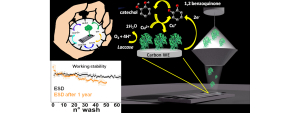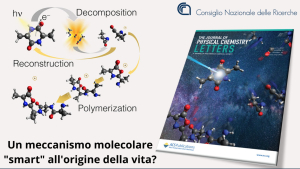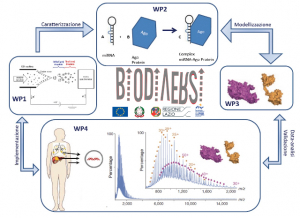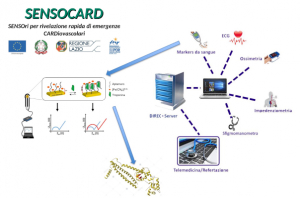Displaying items by tag: MDA_eng
ESILARANTE - ElectroSpray Immobilization of LAccase foR cANnabinoids deTEction
ESILARANTE is a project financed by the MUR as part of the PRIN 2022 call and aims to characterize and develop a portable sensor platform for the detection of tetrahydrocannabinol (THC), based on laccase-based biosensors produced through the green ElettroSpray Deposition technique ( ESD).
An idea born from the collaboration of the CNR - ISM Istituto di Struttura della Materia and the Alma Mater Studiorum - University of Bologna
iSenseDNA - Computation driven development of novel vivo-like-DNA-nanotransducers for biomolecules structure identification
Understanding how a specific molecule performs during complex biological processes is a challenge in biomedical research, despite extensive biotechnological advances in recent years. A new major EU FET project that sees the involvement of CNR-IBBR and CNR-ISM, iSenseDNA, is now focusing on developing a technology to identify what a change in a molecular structure means for its function.
#Supercoiled_DNA #DNA_modelling #optical_analysis #onchip_photonics
Fabrication of a New, Low-Cost, and Environment-Friendly Laccase-Based Biosensor by Electrospray Immobilization with Unprecedented Reuse and Storage Performances
The CNR-ISM together with other Institutes such as ISMN, IGAG and IMAA and with the participation of Sapienza University of Rome and the University of Foggia, has developed a new eco-sustainable technology to produce enzymatic biosensors, which show unprecedented performance in terms of storage and working stability.
Article published on American Chemical Society (ACS), Sustainable Chemistry and Engineering
#biosensor #laccase #electrospray #deposition #immobilization #ecofriendly #green #storage #reuse
A “smart” molecular mechanism at the origin of life?
An experimental and theoretical study, cover article of the J. Phys. Chem. Lett. which has involved researchers from the Institute of Structure of Matter, proposes a model in which simple combinations of amino acids not only survive the interaction with VUV radiation, but exploit it to generate more complex peptide chains.
These mechanisms, which theoretical simulations have shown to be energetically favoured, may have played a role in the early stages of the chemical evolution of life.
#dipeptides #synchrotron #radiation #moleculardynamics
Biomarkers Discovery con ElectroSpray-Mass Spectrometry - BioDivErSI
BioDivErSI is a project funded under the Public Call "Gruppi di Ricerca 2020" POR FESR Lazio 2014-2020
The project will build a prototype instrument that combines an #electrospray ionization source and #mass_spectrometry techniques to develop a new technology for #biomarker discovery and structural characterization. BioDivErSI will focus on the identification and characterization of microRNAs, as non-coding single-stranded RNA sequences, which negatively regulate gene expression at the post-transcriptional level and play a primary role in the development and progress of various viral diseases and infections.
SENSOCARD: SENSOrs for rapid detection CARDiovascular emergencies
SENSOCARD aims to the optimization and field demonstration of an integrated prototype for the diagnosis of cardiovascular emergencies. The prototype is a multifunctional platform that:
- integrates pulse oximeter, sphygmomanometer, ECG and Impedance Cardiography (ICG) signals with blood chemistry values (e.g. troponin) detected from a drop of blood;
- allows the rapid and non-invasive identification of fatal arrhythmias, heart attack and respiratory failure induced by pulmonary edema.
Project partner: Microsis S.r.l., CNR - ISM (Montelibretti branch)
#cardiovascular_emergencies, #electrochemical_sensors
E-CROME project is starting now!
The #E-CROME project, for #telemedicine to assist cancer and terminal patients, is launched.The project, funded by Regione Lazio, Lazio Innova, Call Projects Research Groups 2020 involves the Department of Chemical Sciences and Technologies (DSTC) and the Department of Civil Engineering and Computer Engineering (DICII) of the University of Rome Tor Vergata, the National Research Council (CNR-ISM and CNR-IC) and the Gemelli University Hospital Foundation (FPG).
Nanoscale insights in radiation damage
The objectives of the project are: a) the study of elementary processes of radiation damage in prototype molecules of biological interest by exploiting the potential of innovative instrumentation and b) the study of systems of increasing complexity or molecules in their natural environment with new spectroscopic techniques.
NANO-IBCT - Nano-scale insights in ion beam cancer therapy
To combine the unique experimental and theoretical expertise available within Europe to acquire greater insight at the nanoscopic and molecular level into radiation damage induced by ion impact.
MD-GAS - Molecular Dynamics in the Gas Phase
The Action aims to develop a new physical and chemical toolbox.








 English (UK)
English (UK)  Italiano (Italia)
Italiano (Italia)